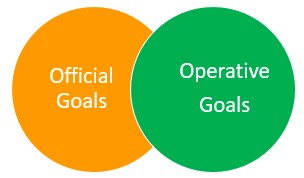Organizational Goals
Organizational goals are strategic objectives that an organizations’ leadership team establishes to outline expected future outcomes toward which present efforts are directed. These goals not only drive the organization as a whole, but also guide employees’ efforts towards achieving the company’s vision.
Two Types of Organizational Goals
There are two main types of organizational goals:
- Official Goals
- Operative Goals
Official goals are the formally stated goals of an organization and are described in its public statements such as the corporate charter, mission statements, and annual reports. The purpose of official goals is to help build the organization’s public image and reputation.
Operative goals are the concrete steps an organization plans to take to achieve its vision and purpose. They are the outcomes the organization actually seeks to attain through its operating activities. These goals are derived from a strategic planning. When most people refer to “organizational goals” they are referring to operative goals.
Organizational Goals and Strategic Plans
Organizational goals are the result of strategic planning. Strategic planning is an organization’s process of defining its direction, developing a strategy, and documenting a plan to pursue that strategy. These goals are defined and detailed in that strategic plan.
Setting Operational Goals
Organizational goals are created in an attempt to achieve a desired future state of success. The goal setting process begins by assessing the organization’s vision and mission. Therefore, it is essential that an organization have a clear mission and vision before it begins to determine its goals.
The next step is the goal setting process is assessing internal factors such as financial resources, physical resources, and human capital as well as external factors such as competitors, product demand, and the economy.
After the assessments are complete, organizations should create a set of cascading goals, beginning with company goals. Department and/or unit goals should then be created to support company goals. Finally, individual employee goals should be created to support the department/unit goals. These multiple levels of goals should be aligned and communicated so that an individual employee understand how their actions contribute to company’s overall success.
Benefits of Goals
- Guidelines for action
- Directs and channels employee efforts
- Justifies a company’s activities
- Identifies development opportunities
- Defines performance standards
- Allocates resources
- Defines standards of performance
- Provides constraints and parameters
- Provides incentives and a source of motivation
Key Organizational Goals
There are several key areas in which most organizations establish goals:
- Market share
- Productivity
- Profitability
- Innovation
- Resources
- Management performance
- Employees performance
- Social responsibility

